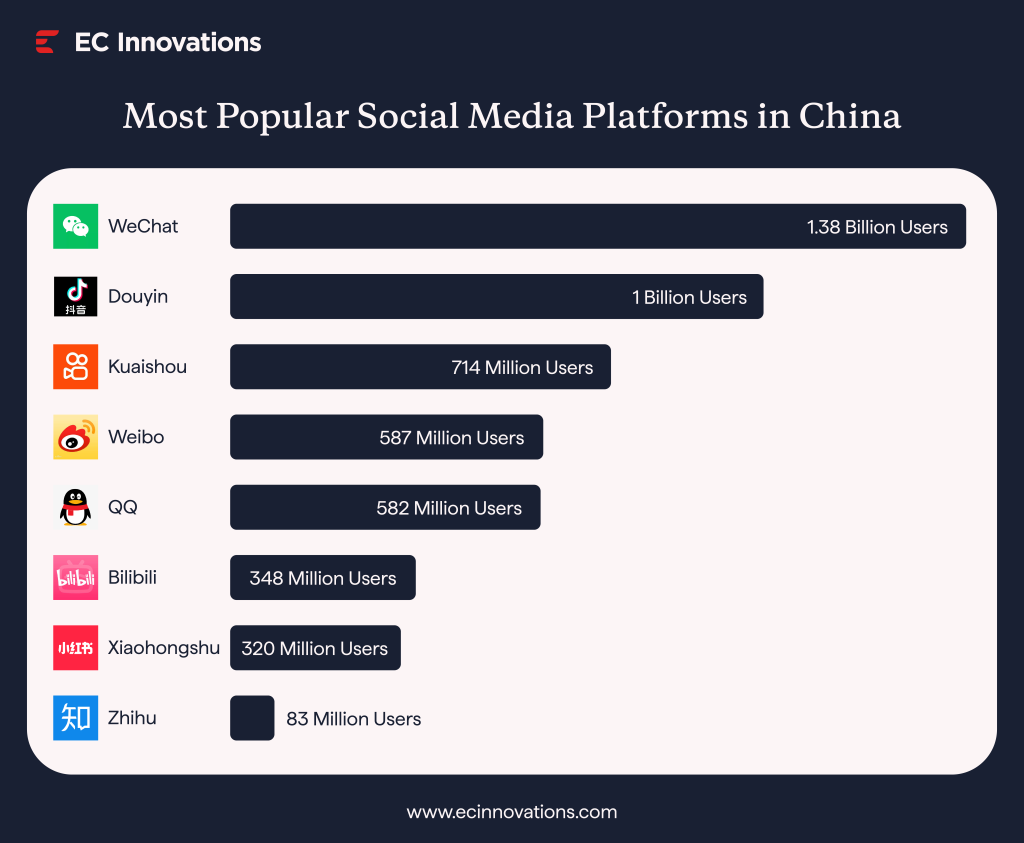Running a business seems great until you realize you’re sleeping on the world’s biggest market. With nearly 1.08 billion (and counting!) social media users in China, the market here is bigger, faster, and a lot more complex than anything you’ve ever seen in the West.
Don’t be fooled, though; tapping into this market is not easy, but not impossible either. What works in Western digital marketing will not work in China.
The reason?
The Chinese audience isn’t using your usual social media platforms — Facebook, X, Instagram — no, they’ve got their own homegrown social media apps where all the action’s at.
Are you ready to learn what platforms are actually worth your time and effort? Here are 8 of the most popular social media platforms in China and why leveraging them for your business might just be your biggest break yet.
Popular Chinese Social Media Apps

1. WeChat

If you were to pick one platform to focus on, it would hands down have to be WeChat. With around 1.38 billion users in 2025, WeChat is commonly referred to as the super app, you know, like the jack-of-all-trades?
From messaging and video calls to online shopping, making payments, and even booking services, WeChat is quite literally used for everything. What makes it so great for business owners is that it allows you to run official accounts, make mini programs engage with customers directly. You’ve also got the handy WeChat Pay option, so transactions and promotions are seamless.
Want to learn how to grow your brand on WeChat? Check out our guide to WeChat marketing.
2. Douyin (Chinese TikTok)

China’s very own TikTok has over 1 billion active users, and it’s the go-to social media platform for short videos. Douyin blends together user-generated content and e-commerce integration so flawlessly, making it a goldmine for marketers wanting to reach Chinese consumers.
Through short-form videos, livestreaming, and influencer collaborations, you can drive sales and create brand awareness all under one roof. Douyin’s nifty e-commerce features also allow users to make purchases directly from the videos.
If your business’s target audience is Gen Z and millennials, you can’t afford to turn a blind eye to Douyin. With attention spans decreasing by the minute, short-form videos are the future, and with Douyin, you’ll be dominating the market.
3. Weibo

Weibo is often compared to the rest of the world’s Twitter, or now X, but it’s actually so much more. It’s currently got over 580 million users and is your go-to app for all things news, viral content, and hot takes on everything from politics to pop culture. If your brand is looking to spark conversation, get people talking, and interact with your consumers directly via likes, shares, and comments, Weibo is your answer.
Hashtags and trending topics are great for viral marketing, and Weibo is a good place to start if you want to build a presence.
4. Xiaohongshu (Little Red Book)

The lifestyle app, Xiaohongshu or Little Red Book, has seen drastic growth over the past couple of years. In 2025, it’s got roughly 320 million users, and while it started out as a lifestyle and product recommendation app, it’s grown to be so much more.
Some would say it’s the result of putting Pinterest and Instagram into one, but add a strong emphasis on shopping into the mix. If your brand is in the fashion, lifestyle, or beauty sector, you could really boost your business by making a presence here. Users typically use the Little Red Book to discover products, share reviews, and get advice from fellow users. You could even leverage influencer marketing on here!
5. Kuaishou

Kuaishou, which quite literally translates to fast hands, is all things vlogging and livestreaming. It’s been gaining ground, especially in rural and lower-tier areas, and currently has around 714 million daily users. While most of the apps we’ve mentioned above focus on filtered content, Kuaishou stands out for its raw and unfiltered content.
If your brand aims towards a rather down-to-earth audience that appreciates authenticity, Kuaishou could do wonders for your user engagement.
6. Bilibili

Bilibili is yet another video sharing platform, however, this time it’s mostly for anime, gaming, and youth culture. It’s got around 348 million users and is perhaps China’s most vibrant and niche communities yet. If you’re looking to tap into a market that’s passionate about gaming and anime, you’ve just hit a jackpot.
Bilibili is all about sharing and creating content on games, comics, and pop culture. The audience you’ll find here is between the ages of 18 and 35, making it ideal for entertainment businesses.
7. Zhihu

Just like half the globe relies on Quora to answer their questions, China relies on Zhihu. You’ll find around 83 million active users on here sharing their thoughts, experiences, and knowledge on technology, education, and finance.
Zhihu is a great place to start if you’re looking to build authority on any of these sectors, since businesses and professionals are constantly sharing insights and participating in niche discussions.
8. QQ

Last, but not least, we’ve got QQ. What started out as a messaging app in 1999, QQ has expanded to social networking, gaming, and even e-commerce. For marketers, QQ offers opportunities for creating groups, forums, and engaging users with targeted content. It’s especially popular among students and young professionals under the age of 25, making it ideal for brands targeting a younger audience.
Strategies for Leveraging Chinese Social Media Platforms
So you now know about China’s most popular social media platforms, it’s time to make them work for you. Just knowing about them isn’t enough; you need to know how to navigate them.
Here’s how you can make maximum impact:
1. Think Local
Content localization isn’t about translating your business website and calling it a day. You need to really understand the Chinese culture, tap into local trends, and get your message across.
2. Collaborate with Key Opinion Leaders
Trying to tap into the Chinese market with key opinion leaders (KOLs) is like trying to find your way in an unknown city without a map — painfully slow and, quite frankly, pointless. KOLs are real people your audience trusts, celebrates, and looks up to. They can help boost sales, drive conversions, and everything else in between. Don’t try to make it without one.
3. You’re No Longer Just Posting, You’re Selling
Gone are the days when social media platforms and e-commerce apps were divided by a boundary. Those boundaries are now blurred — people are buying as they scroll, which is literally everywhere, every time. Apps like Douyin, WeChat, and Xiaohongshu allow users to shop directly from posts.
Do you know what this means? You need to make buying as easy as liking a post. Customers want to buy. Now. Stop making them jump through hoops.
4. Mobile-Friendly is the New Sales-Friendly
Were you aware that over 99 % of China’s internet users access the web via their mobile phones?
If your content isn’t optimized for mobile, you might as well be throwing your marketing budget out the window. Social media in China is tailored for mobile use, and your strategy should be too.
Chinese Social Media Trends to Look Out for in 2025
What’s coming down the pipeline in the Chinese social media world that marketers should be paying attention to?
1. Short-Form Video Will Dominate (Even More)
You’ve heard it before, but short-form video is everything in China. The popularity of apps like Douyin and Kuaishou shows that users are glued to their screens for quick, digestible content.
In 2025, expect this format to only grow bigger, so if you’re not doing short-form videos, you’re behind.
2. AI and Personalization Are Here to Stay
AI-driven marketing has taken the world by storm, and China is no different. From hyper-targeted ads to personalized shopping experiences, AI will continue to evolve and make content feel even more tailored to individual needs.
3. Livestream Shopping Becomes the New Norm
Livestream shopping is already huge in China, and it’s only getting bigger. We predict live shopping events to be so embedded into platforms like Douyin and Xiaohongshu that live sessions by brands will be considered the norm.
Normal is Cancelled. Try Unforgettable.
The Chinese social media landscape is wildly different from what you’re used to in the West. Chinese social media platforms offer exciting opportunities, but they also come with their fair share of challenges.
To succeed in China, you need more than just a translation. You need a strategy that’s well-thought-out and localized.
Adapt your content, respect the culture, and stay on top of trends. The market moves quickly, and the apps? Well, they’re evolving even faster.
Stay agile, stay creative, and stay ahead. And to do that, EC Innovations can help. If you’re ready to rise above the background noise and get your message across, get in touch with us for our localization and translation services.



